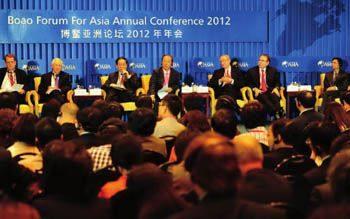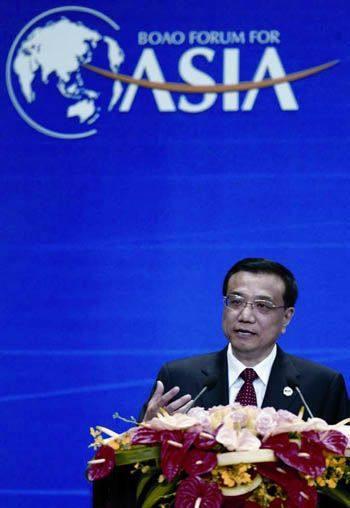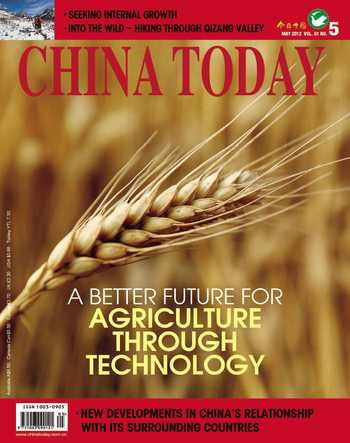Seeking internal growth
YU LINTAO

IN an era of globalization, Asia is not immune to the challenges facing the world economy. The stillgloomy global economy casts a shadow on the sustainability of the Asian economy.
How Asia should maintain sustainable development amid global economic uncertainties became a focus of this years Boao Forum for Asia (BFA) held in south Chinas Hainan Province on April 1-3.
“While continuing to unleash its comparative advantages in global competition, it is important for Asia to explore and expand markets of domestic demand,” said Li Keqiang, Chinese vice premier, when delivering a speech at the opening ceremony of the 2012 annual conference of the BFA.
“Asian countries should be able to walk using both legs,” said Goh Chok Tong, former Singaporean prime minister, at the forum. If global demand withers, internal drivers of growth will play an important role in supporting the economy. More cooperation, trade and investment should be encouraged among Asian economies, he said.
During the last decade the economic output of Asia has grown from 15 percent to 30 percent of the world total. If the growth momentum continues, it will make up half of the world economy by 2050. But the shrinking of world markets after the financial crisis hit the exportoriented Asian economy hard.

“Asian economies rely heavily on exports, investment and resource exploitation. Because the investments are mainly from the West and most of the export markets are also Western countries, Asias economic model showed its uneven and unsustainable nature,” said Zeng Peiyan, vice chairman of the Board of Directors of the Boao Forum for Asia(BFA).
Thus, restructuring the export-oriented economy and boosting domestic markets should be a priority for Asian countries, said Zhang Yuyan, director of the Institute of World Economics and Politics under the Chinese Academy of Social Sciences.
In seeking internal growth engines, Asia has its own unique advantages. As home to around 45 percent of the worlds population, there is huge potential in the Asian domestic markets.
Asia is a dynamic and diverse region with different political regimes, economic models and cultural traditions. But one common goal of Asian countries at present is striving for economic development and modernization, said Fan Bi, deputy director of the Department of General Research of the State Council Research Office.
“Based on that point, the concept of seeking internal growth could be widely accepted by Asian economies. It is of great significance for the healthy and sustainable development of the Asian economy and promoting its ability for fending off all kinds of risks,” Fan said.
Hurdles
To maintain sustainable development, most Asian countries are also facing some problems such as aging, employment and income and wealth inequality.
During the past several decades, lowcost labor force in Asian countries has helped a lot in their export-oriented industries and earned large foreign exchange reserves.
Because, however, many Asian coun- tries are aging rapidly, analysts say the so-called demographic dividend of those countries is likely to come to an end in the next eight to 20 years.
Shoei Utsuda, chairman of the Board of Directors of Mitsui Co., Ltd., said Asian countries should be fully aware of the magnitude of the aging problem.
Since 1950, Japan enjoyed an economic upswing with the rapid growth of population. But when it entered a stage of graying society after 1990, Japan began falling into an economic decline. It has spent two uncomfortable decades adjusting to an era of slower growth and graying population, Utsuda said, adding that other Asian countries are advised to prepare to deal with the issue in advance.
To address the problem, the free flow of people, goods, services and capital within Asian area would be helpful, Utsuda said. Just as Chinese Vice Premier Li stressed in his speech, openness and inclusiveness work. It could also help to form a sound development model in the region, Utsuda said.
Professor Chen Zhiwu from Yale University claims that aging could also be an opportunity. For example, China could seize the chance to get over the over-dependence on the export market and boost its domestic market since aging could produce large demand in the service sector.
Emerging Asian countries have accumulated a lot of wealth during the rapid growth of the past decades. But wealth inequality has become an obstacle to development.
Richard Boucher, deputy secretary general of the Organization for Economic Cooperation and Development, said income and wealth inequality mostly hurts disadvantaged groups, who struggle to get good education and health care. Therefore, governments should address the problems through tax and legislation to guarantee the medical security, education and work rights and pension of the less fortunate.
Fair distribution, equal access to medical care and education, and opportunity for advancement for all people should be key policies that governments must emphasize, Abdullah Badawi, former Malaysian prime minister, said at the forum.
Qin Xiao, Boyuan Foundation chairman, said that wealth inequality is a global issue. In China, one of the important factors is that fiscal expenditure is too high, but the proportion spent on peoples livelihood is low.

Qin also said China should adjust its industrial policy. The government should give more support to the service industry, which could provide more job opportunities and improve income distribution.
Maintain the Miracle
“Under the new circumstances, Asian countries need to enhance their consultation and cooperation,” said Chinese Vice Premier Li. “Openness and cooperation benefits all and leads to win-win progress.”
“Achievements and experience Asian economies got from past regional cooperation have laid a solid foundation for further cooperation in different areas in the post-crisis era,” said Zeng, vice chairman of BFAs Board of Directors.
Intra-Asian trade has accounted for over half of Asian countries total foreign trade, allowing them to reap handsome dividends for development, Li said.
The pressure and challenges brought by the crisis might also become fresh impetus for further cooperation among Asian economies, Zeng said.
Actually, current Asian economic integration is much lower than in developed areas such as Europe. There are still big developmental differences between Asian economies. Though regional and subregional cooperation mechanisms such as ASEAN and the South Asian Association for Regional Cooperation have laid some foundations, cooperation among Asian economies is mainly focused on trade and investment.
“There is still great potential for further cooperation among Asian countries,” Zeng said. “Strengthening comprehensive economic cooperation within the region will be a wise choice to continue the ‘Asian miracle and achieve the sustainable development of all Asian economies.”
Boao Forum for Asia
The Boao Forum for Asia Annual Conference 2012 was held April 1-3 in Boao, south Chinas Hainan Province.
More than 2,000 delegates and media personnel from around the world participated in the conference, including over 40 ministers from different countries and leaders from different international organizations, as well as world renowned economists and entrepreneurs. One third of the guests to this years forum came from the United States and European countries.
The theme for the 2012 conference was Asia in the Changing World: Moving toward Sound and Sustainable Development. Seminars were held on topics including identifying uncertainties and root causes of the debt crisis, employment and growth; pushing for reform and transformation through discussions on reforming the international monetary system and addressing income and wealth inequalities; seeking sustainable development through innovative thinking in life sciences, cloud computing, mobility and social media.
Aside from various sessions organized along these lines, the annual conference has as always included faceto-face dialogues among young leaders, CEOs of multinational companies, overseas Chinese business leaders, CEOs from across the Taiwan Straits, private sector executives and women leaders.

